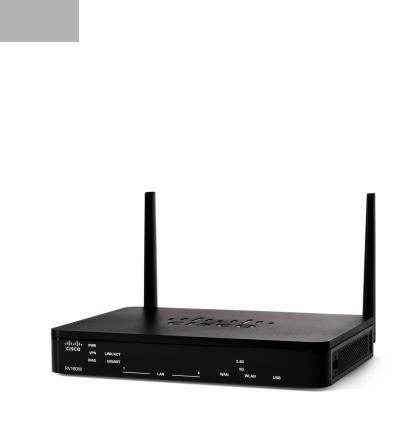Cisco RV160W operation manual

Quick Start Guide
Cisco RV160W Router
Package Contents
•Cisco RV160W Router
•Power Adapter
•This Quick Start Guide
•Pointer Card/RoHS
•Technical Support Contact Card
•Ethernet Cable
•EU Directives 2014/53/EU Compliance Information (for EU SKU only)

Welcome
Thank you for choosing the Cisco RV160W router.
The RV160W router provides reliable Internet access connectivity and includes the following features:
•Easy to use UI with multiple set-up wizards.
•Four port wireless-AC VPN router.
•Supports IPv6 firewall.
•Dualband WLAN (2.4 and 5GHz)
•Business-grade small business network in a box.
This guide describes how to install your Cisco RV160W and launch the web-based Device Manager.
1 Installing the Cisco RV160W
To prevent the device from overheating or being damaged:
•Ambient Temperature — Do not operate the device in an area that exceeds an ambient temperature of 104°F (40°C).
•Air Flow — Be sure that there is adequate airflow around the device. If wall mounting the device, make sure that the heat dissipation holes are to the side.
•Circuit Overloading — Adding the device to the power outlet must not overload that circuit.
•Mechanical Loading — Be sure that the device is level and stable to avoid any hazardous conditions, and that it is secure to prevent it from sliding or shifting out of position. Do not place anything on top of the device, as excessive weight may damage it.
Desktop Mounting
For desktop mounting, place the device on a flat surface so that it sits on its four rubber feet.
Wall Mounting
The router has two wall-mount slots on the bottom panel. To mount the router on a wall, you will need to use the wall-mount kit screws (included).
2 |
Cisco RV160W Router Quick Start Guide |

Guidelines for Mounting the Router on a Wall
When choosing a location for mounting the router on a wall, consider cable limitations and wall structure.
•Mount the router with the front panel facing upward. Make sure to mount the router low enough so that you can see the LEDs.
•Make sure that the power supply rests on a horizontal surface such as the floor or a table. If the power supply is not supported, the strain on the power adapter cable could cause it to disconnect from the router.
•Do not install the router or its power supply next to a heat source of any kind, including heating vents.
You can mount the router on a hollow wall or a wall stud. To mount the router, follow these steps:
STEP 1 Position the router on the wall to determine where to attach the two mounting screws. Drill two pilot holes at approximately 109 mm apart.
STEP 2 Insert a screw into each hole, leaving a gap between the surface and the base of the screw head of 1 to 1.2 mm.
STEP 3 Place the router wall-mount slots over the screws and slide the router down until the screws fit snugly into the wall-mount slots.
WARNING Insecure mounting might damage the router or cause injury. Cisco is not responsible for damages incurred due to insecure wall-mounting.
WARNING For safety reasons, please ensure that the heat dissipation holes are facing sideways.
Cisco RV160W Router Quick Start Guide |
3 |

2 Cisco RV160W Features
Front Panel
PWR |
Power off or in rescue mode. |
|
Solid green when the power is on and in normal |
|
operation. |
|
Flashing green when the device is booting up. |
|
|
VPN |
Off when no VPN tunnel is defined, or all defined |
|
VPN tunnels have been disabled. |
|
Solid green when at least one VPN tunnel is up. |
|
Flashing green when transmitting or receiving |
|
data over VPN tunnel. |
|
Solid amber when no enabled VPN tunnel is up. |
|
|
DIAG |
Off when the system is on track to bootup. |
|
Slow blinking red (1Hz) when the firmware |
|
upgrade is in progress. |
|
Fast blinking red (3Hz) when the firmware |
|
upgrade is failing. |
|
Solid red when the system failed to boot-up with both |
|
active and inactive images or in rescue mode. |
|
|
LINK/ACT of WAN |
Off when there is no Ethernet connection. |
and LAN1-4 |
Solid green when the GE Ethernet link is on. |
|
|
|
Flashing green when the GE is sending or |
|
receiving data. |
|
|
GIGABIT of WAN |
Solid green when at 1000M speed. |
and LAN1-4 |
Off when at non-1000M speed. |
|
|
|
|
WLAN 2.4GHz |
Off when the 2.4GHz wireless module is disabled. |
|
Flashing green when the wireless radio is |
|
transmitting or receiving data. |
|
Solid green when the 2.4GHz wireless module is |
|
enabled. |
|
|
4 |
Cisco RV160W Router Quick Start Guide |
